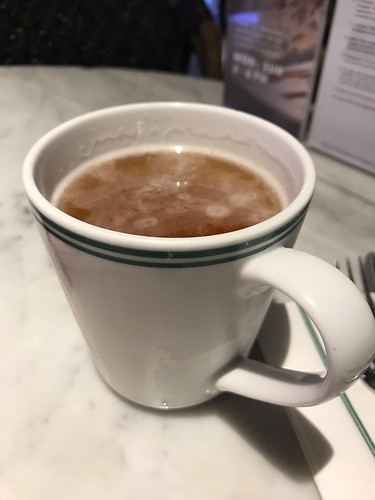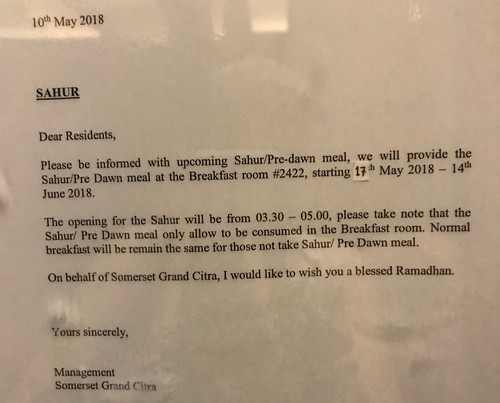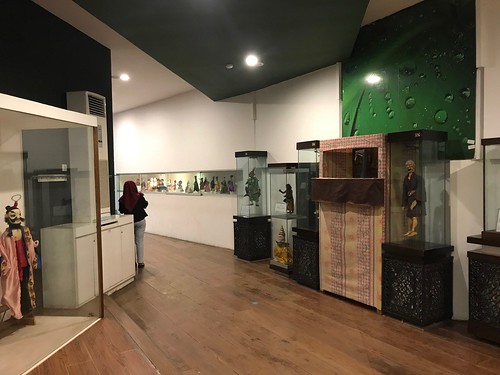I’m still not really succeeding at being a tourist in Jakarta, and time’s a-wastin’. I’m clinging desperately to five-day work weeks, but that’s only going to last until rehearsals start in earnest and it’ll be time to put my head down and not look up until September. Until then I should really be taking advantage of my weekends to do Things. Colleagues are known to bring a carryon bag to the office on Friday and go straight from their desks to the airport to visit Bali or Yogyakarta or go diving or see Komodo Dragons or something. Maybe this is a sign that the novelty of this sort of work is wearing off for me - the fact that all I really want to do on a weekend is sleep in, make myself a nice breakfast, relax in air-conditioned comfort and maybe sit in a quiet coffee shop with the crossword. Still even with that agenda, there are things I can tell you about because everyday life continues and sometimes it’s different or notable or just plain weird.
On the freelance nature of traffic control:
I may have mentioned before that traffic in Jakarta is a problem. In fact, it's simply an inescapable fact of life. There are too many cars on the road, which, added to a seemingly infinite number of motorcycles that fill any gap like an angry swarm of insects, added to a somewhat approximate sense of the rules of the road mean that something as simple as turning or parking can become a real challenge.
Here’s where the entrepreneurial spirit emerges in the form of the freelance traffic warden. Known locally as “Coin Police” or “Parking Masters” these are men who stand at intersections or turning points or parking spots and direct traffic. Note that I’m not talking about actual uniformed municipal police here. Those also exist in a small number of places, but the freelance guys are much more common.
Here’s how it works. Your car approaches an intersection - often this is a designated place for a u-turn, which are a very common here. Standing in the road, among the moving vehicles, will be a guy who’s basically putting this body between you and the oncoming cars to help you filter into the flow of traffic. He waves his arms and holds up a hand to try and stop or slow the cars enough that you can merge. Sometimes it works, sometimes he gets ignored. He does this for tips, usually between 2,000 and 5,000 rupiah, which is between 10 and 30 pence. So if you're inclined, you roll down the window and slip the guy a bit of cash as you roll past.
The Coin Police also work a parking angle, where they’ll stop traffic to allow you to turn into a spot or help you exit and merge back into traffic. The parking guys also get some money for the actual "rental" of the parking spot. I assume it’s entirely unregulated and simply a case of one guy having a “patch” he works by general agreement, but who knows? Maybe there’s a central ministry that assigns dominion over parking spots on a fair rota. (Sure…)
I find the whole thing alternately charming and terrifying. But I do have a soft spot for the guys who works one particular intersection that’s on my morning 5k running route.
Recently on morning runs I’ve been packing 1,000 rupiah in coins and giving it to the guy at this intersection as I run past. I figure anything I can do to help cross smoothly and easily is worth it. However, this is highly unusual or perhaps even unprecedented. I told some local colleagues about my habit and they found it utterly hilarious that I would tip the coin police as a pedestrian. But I find it fun to think about this guy going home at the end of a shift and telling his buddies about the crazy giant foreign woman who tips him when she runs past. I’m going to make an impression anyways, so why not?
On the horrors of the food court:
I know I talked about inappropriate cheese already but I really can’t let this particular nugget go without a special mention. The food hall in the big mall next door has a lot of odd offerings that I’ve yet to tell you about. For instance, there’s the Cheese Tea (Actual slogan: “Where cake meets cheese. Yum!”) and there’s the Pizza Cones (Actually overheard: “The macaroni was… unexpected”) and squid balls and… well I could go on and on. Recently a cheap-and-cheerful takeaway sushi place has popped up and I’ve taken advantage on a couple nights when I couldn’t be bothered to cook. It’s definitely on the low-rent end of the sushi spectrum, but even so, I was shocked and appalled to see this on offer.
On the holy month of Ramadan:
And finally, Ramadan Mubarek! Ramadan is the ninth month of the Islamic calendar and is set aside as a period of fasting and increased piety for Muslims. Observance of Ramadan is considered one of the Five Pillars of Islam and this is the first time I’ve been in a really religious Muslim country during the holy month. (Azerbaijan is a much more secular place so there was little impact on day to day life.) The chief feature of Ramadan is the fast, which is observed during daylight hours, meaning that no food or drink is consumed between sunrise and sunset (and yes that includes water, which in a country with a climate like this must be particularly challenging). Fasting is mandatory for all adult Muslims (with a few exceptions). The term sawm is used to refer to fasting but it translates more literally as “refrain” which encompasses a more general abstinence from more than just food and drink, but also smoking, sex, impure thoughts and evil deeds.
My first inkling that things would be a bit different during Ramadan was when I went for dinner and ordered a beer to accompany my meal. It was after sunset, but even so the waiter informed me that because it’s Ramadan, they serve beer in a coffee mug. Because… I don’t really know. I guess because everyone is trying to be more devout so they want to conceal the fact that alcohol is being drunk. Also, some local restaurants in the area that have outdoor patios put up curtains between the patio and the street during the day. I suppose this is to shield those fasting from seeing those who aren’t.
Also, a notice appeared last week at the hotel informing us that a special breakfast buffet would be available from 3:30am to 5:30am for sahur - the pre-fast morning meal.
More significant though, is breaking the fast at sunset, called iftar in arabic, but known in Indonesia as buku puasa. Apparently it’s traditional to break the fast first by eating an odd number of dates. So when I and some colleagues went out to watch the royal wedding at a local ex-pat bar and had beer and curry, they brought us a little plate of dates first (because I’d ordered the special “break your fast” thali tray, also thankfully available to the non-observant).
(Aside - and at that moment I was struck once again with how odd my life is sometimes. Sitting in a quasi-Irish pub in Jakarta with American, Irish and Australian colleagues, eating a buku puasa of curry and watching an English prince marry an American actress. It reminded me of a dinner not so long ago in a Georgian restaurant in Azerbaijan when my companions were Greek and Australian and we watched a Russian news network’s coverage of Donald Trump being sworn in. I guess if they gave out points for cross-cultural-ness I’d have a pretty healthy balance.)
Anyway, back to Ramadan. There hasn’t been much change to the routine in the office. However many of the local staff are fasting so us infidels have been asked to eat our lunches and drink our coffee in a spare meeting room instead of stuffing our faces in front of our more devout colleagues. Ramadan lasts for a lunar month, so this will continue until mid June when there’s a big holiday - the most important of the year. Edul Fitri, also known as Lebaran in Indonesia, is the feast of fast-breaking. It’s the rough cultural analogue to Christmas in Western culture, not because of any religious equivalence, but simply because it’s the longest holiday of the year and the one where most people travel home. This means all our local staff have about a week off and much of the normal activity in the country will shut down while people celebrate with friends and family. I'll be taking advantage of this lull in activity to sneak in a week’s vacation before the real madness starts, at a location that promises to be highly blog-worthy, as long as I can find the time to write about it.
And that's all I've got for you this week. I think I've got one or two posts left in me before I abandon the blog again until the end of this job, so enjoy it while it lasts. In the mean time I'm off to the mall for a snack that definitely will not include processed cheese slices.
On the freelance nature of traffic control:
I may have mentioned before that traffic in Jakarta is a problem. In fact, it's simply an inescapable fact of life. There are too many cars on the road, which, added to a seemingly infinite number of motorcycles that fill any gap like an angry swarm of insects, added to a somewhat approximate sense of the rules of the road mean that something as simple as turning or parking can become a real challenge.
Here’s where the entrepreneurial spirit emerges in the form of the freelance traffic warden. Known locally as “Coin Police” or “Parking Masters” these are men who stand at intersections or turning points or parking spots and direct traffic. Note that I’m not talking about actual uniformed municipal police here. Those also exist in a small number of places, but the freelance guys are much more common.
Here’s how it works. Your car approaches an intersection - often this is a designated place for a u-turn, which are a very common here. Standing in the road, among the moving vehicles, will be a guy who’s basically putting this body between you and the oncoming cars to help you filter into the flow of traffic. He waves his arms and holds up a hand to try and stop or slow the cars enough that you can merge. Sometimes it works, sometimes he gets ignored. He does this for tips, usually between 2,000 and 5,000 rupiah, which is between 10 and 30 pence. So if you're inclined, you roll down the window and slip the guy a bit of cash as you roll past.
This is an exceptionally well-equipped guy in Jember, complete with hi-vis vest and flag. His corner was pretty slow, making me wonder how this line of work could ever pay off, especially with the overhead of flag and vest to consider.
Here’s another guy in Jember, who’s even got a bucket for collecting his money. Again, this is a very tame intersection. In Jakarta it’s a much more hectic scene.
I find the whole thing alternately charming and terrifying. But I do have a soft spot for the guys who works one particular intersection that’s on my morning 5k running route.
Here’s my guy!
On the horrors of the food court:
I know I talked about inappropriate cheese already but I really can’t let this particular nugget go without a special mention. The food hall in the big mall next door has a lot of odd offerings that I’ve yet to tell you about. For instance, there’s the Cheese Tea (Actual slogan: “Where cake meets cheese. Yum!”) and there’s the Pizza Cones (Actually overheard: “The macaroni was… unexpected”) and squid balls and… well I could go on and on. Recently a cheap-and-cheerful takeaway sushi place has popped up and I’ve taken advantage on a couple nights when I couldn’t be bothered to cook. It’s definitely on the low-rent end of the sushi spectrum, but even so, I was shocked and appalled to see this on offer.
This is exactly what is looks like. Half a processed cheese slice on top of sushi rice, drizzled with yet more plastic cheese, this time in liquid form. For the love of all that is holy people… how can this actually be a thing? Words fail me.
And it doesn’t stop there, because you can get the same thing in a roll! Please Indonesia! Please stop! And Japan… where’s the quality control here? This is your thing. Surely you should have some kind of monitoring system in place to prevent these kind of atrocities.
On the holy month of Ramadan:
And finally, Ramadan Mubarek! Ramadan is the ninth month of the Islamic calendar and is set aside as a period of fasting and increased piety for Muslims. Observance of Ramadan is considered one of the Five Pillars of Islam and this is the first time I’ve been in a really religious Muslim country during the holy month. (Azerbaijan is a much more secular place so there was little impact on day to day life.) The chief feature of Ramadan is the fast, which is observed during daylight hours, meaning that no food or drink is consumed between sunrise and sunset (and yes that includes water, which in a country with a climate like this must be particularly challenging). Fasting is mandatory for all adult Muslims (with a few exceptions). The term sawm is used to refer to fasting but it translates more literally as “refrain” which encompasses a more general abstinence from more than just food and drink, but also smoking, sex, impure thoughts and evil deeds.
My first inkling that things would be a bit different during Ramadan was when I went for dinner and ordered a beer to accompany my meal. It was after sunset, but even so the waiter informed me that because it’s Ramadan, they serve beer in a coffee mug. Because… I don’t really know. I guess because everyone is trying to be more devout so they want to conceal the fact that alcohol is being drunk. Also, some local restaurants in the area that have outdoor patios put up curtains between the patio and the street during the day. I suppose this is to shield those fasting from seeing those who aren’t.
Mmmmm... mug o' beer!
That little sticker correcting the start date is probably because the start of Ramadan is based on visual sighting of the crescent moon so can only be estimated until it actually happens.
More significant though, is breaking the fast at sunset, called iftar in arabic, but known in Indonesia as buku puasa. Apparently it’s traditional to break the fast first by eating an odd number of dates. So when I and some colleagues went out to watch the royal wedding at a local ex-pat bar and had beer and curry, they brought us a little plate of dates first (because I’d ordered the special “break your fast” thali tray, also thankfully available to the non-observant).
(Aside - and at that moment I was struck once again with how odd my life is sometimes. Sitting in a quasi-Irish pub in Jakarta with American, Irish and Australian colleagues, eating a buku puasa of curry and watching an English prince marry an American actress. It reminded me of a dinner not so long ago in a Georgian restaurant in Azerbaijan when my companions were Greek and Australian and we watched a Russian news network’s coverage of Donald Trump being sworn in. I guess if they gave out points for cross-cultural-ness I’d have a pretty healthy balance.)
And cheers to a good thali tray! Not quite up to the level of Adam’s Curry in Baku, but we take what we can get.
And that's all I've got for you this week. I think I've got one or two posts left in me before I abandon the blog again until the end of this job, so enjoy it while it lasts. In the mean time I'm off to the mall for a snack that definitely will not include processed cheese slices.


















